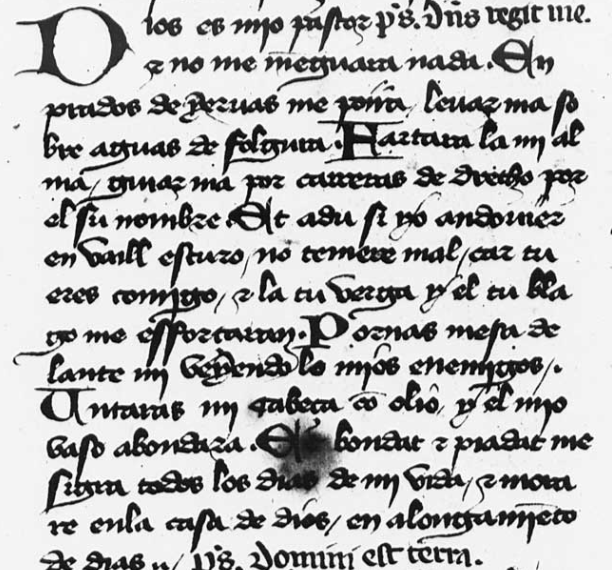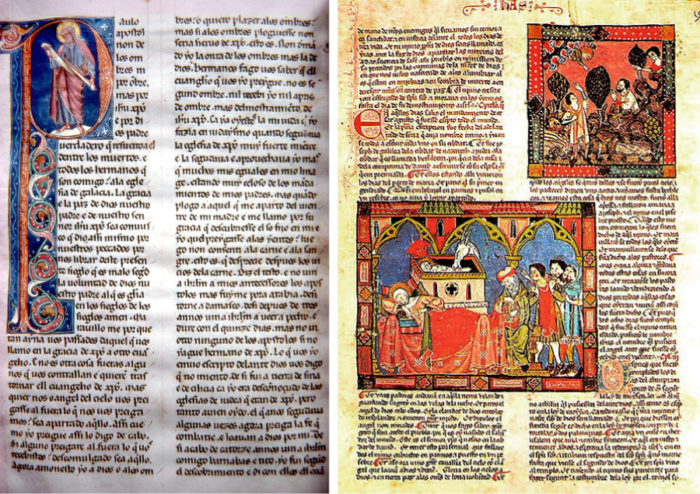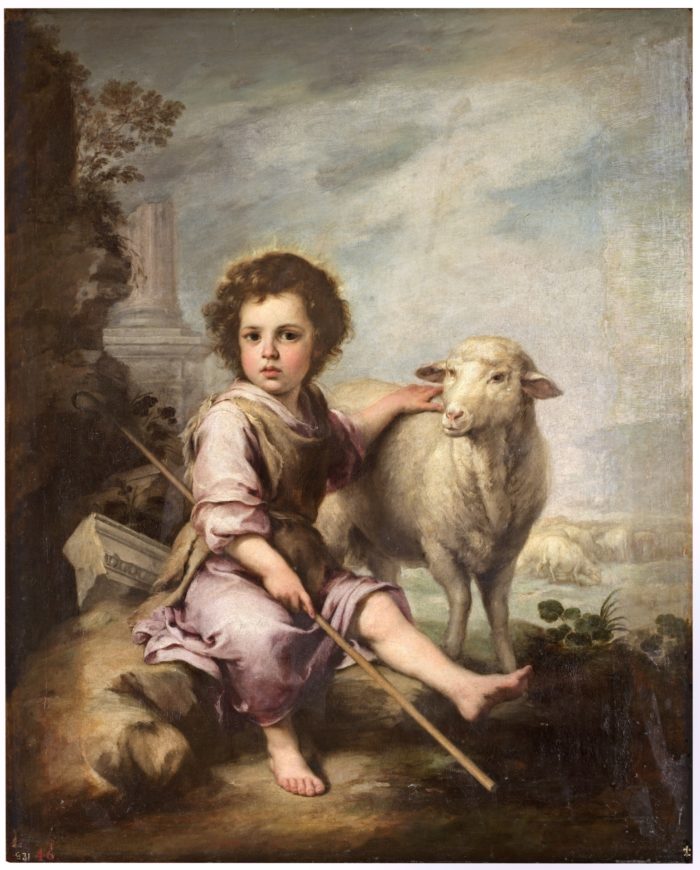Pre-Alfonsine Bible (E6/E8)
Pre-Alfonsine Bible (E6/E8)
by Kassandra Portillo Saltos

Project: Biblia Medieval
This project of the digitalization of different Bibles has as a main goal, according to the webpage Biblia Medieval (n.d) to be an: “open access resource to facilitate the study and dissemination of a singular aspect of Hispanic medieval language and culture: the translations of the Bible into Spanish carried out during the Middle Ages.”
- Author: Unknown
- Title: Biblia Prealfonsí (E6/E8)
- Date: 13th Century
- Edition: Ancient Kingdoms of Castilla and León, constituted by 2 manuscript codices, classified as E6 and E8.
- Editor: Unknown
- Pages: Non paginated: E6 Contents: Old Testament: Proverbios, Eclesiastés, Cantar, Sabiduría, Eclesiástico, Isaías, Jeremías, Lamentaciones, Baruc (with Epístola de Jeremías), Ezequiel, Daniel (with the Oración de Azarías, el Himno de los tres jóvenes, la Historia de Susana y la Historia de Bel y el Dragón), Doce Profetas y Macabeos 1-2. New Testament: Hechos de los Apóstoles, Epístolas de san Pablo, Epístola de Santiago Apóstol, Epístolas de san Pedro Apóstol, Epístolas de san Juan, Epístola de san Judas y Apocalipsis. E8 Contents: Old Testament: Levítico (from 7:1 and so on), Números, Deuteronomio, Josué, Jueces, Rut, Samuel 1-2, Reyes 1-2, Crónicas 1-2, Esdras, Nehemías, Esdras 3, Tobías, Judit, Ester, Job, Salmos (just until 70:18).
- Language: Vernacular Spanish; E6: Castilian Spanish, E8: Navarrese-Aragonese language.
- Source: http://corpus.bibliamedieval.es/
Purpose
What we know today as the Pre-Alfonsine Bible is constituted by 2 manuscript codices that are mostly classified as E6 and E8. These manuscripts date back from the 13th Century and are nowadays guarded in the Escorial Monastery Library.Thought to have first seen the light in the Kingdoms of Castilla and Leon when they were becoming unified and stronger, the E6 manuscript is normally considered to have been copied close to the original date of composition in 1250 while the E8 is thought to be dated closer to the year 1400.
The importance of the existence of these pieces relies on the fact that thanks to them we have access to a reconstruction of a practically complete text of a Bible written in Romance, that most likely marks the evidence of the first efforts of translating it to make the knowledge available for more people.
Formal aspect
In a sense, these two codices compliment each other. Although, not even working with them together they complete the entire Bible as we have it nowadays. Moreover, another important fact is that there is a difference in the languages, although the basics is obviously the Spanish the E6 is written in Castilian Spanish whereas the E8 has the Navarrese-Aragonese language as a distinction.
The webpage Bible Translation in Medieval Spain (n.d) mentions that the Pre-Alfonsine and the Alfonsine Bible will be recognize because they “helped to establish and enrich the nascent Spanish language”, quoted in the same webpage, it is mentioned the Scholar Thomas Montgomery who says about the Pre-Alfonsine Bible that: “the translator of this Bible produced an admirable work with regard to accuracy as well as elegant language…The language is simple and clear, as needed for a Bible prepared for people unversed in Latin” (n.d). These two items will also be considered the largest translation from the Latin Vulgate into Spanish of that time.
Moreover, another important fact is that there is a difference in the languages, although the basics is obviously the Spanish the E6 is written in Castilian Spanish whereas the E8 has the Navarrese-Aragonese language as a distinction, therefore these codices will also become the longest extant pre-Alfonsine Castilian text, it is a treasure trove of early Castilian linguistic forms.
Value given to the edition
The Pre-Alfonsine Bible will be of crucial importance for the Spanish language and literature. As mentioned before, it is a translation from the Latin into the Castilian and Navarrese-Aragonese language, which will be languages that can be dated to the end of the 12th Century. The E6 part of the Bible is in fact a witnesses of one of the oldest examples of Castilian literature in prose.
This Bible will contain the translation of almost all the books of the Vulgate, making it the most extent one until the Alfonsine Bible. The Pre-Alfonsine documents will recover the Vulgate from the Latin that had made the translation directly of the Hebrew and Greek Bible of the end of the 4th Century.
Political value
In the late Middle Ages the Spanish speaking population reflected an important amount of people and it comes as no surprise that during this time there will be the first translations of the Bible that were originally in the Latin Vulgate to the Castilian and Spanish in the Iberian Peninsula, which will constitute the idea of a new powerful and important language that would be very important for spreading the Word of God, and so this will now be expanding beyond only those who were educated enough to read and understand Latin.
As a result, there will be the very first and new translations, something that will anger the church, mainly because they thought it could lead to several misinterpretations of the words exposed on the Bible but as the translations become more popular and requested, the Church will organize a council in 1242, better known as the Council of Tarragona named like this because it was held in this city in Spain. According to the Historical Meaning of Inquisition webpage (n.d) in this Council, several varieties of heresies will be defined and graded considering their severity, one of these heresies will be the owning or working on a translation of the Bible to any other language besides Latin, the decreed will then be clear: everybody had to hand over the vernacular versions of their Bible to the local clergy for them to be burned.
The decree did not decrease the interest people had in working and perfecting the translations. Reaching up to this point, it is very important to present a person that will mark a difference when it comes to the translations of the Bible, at least for the Spanish language: the King Alfonso X (1252-1284), who is considered to be the founder of Spanish prose, he wanted the translation of the Scriptures into the new language and supported it, opening the path for the Alfonsine Bible that will become the largest translation into Spanish of its time.

Transcription
Biblia prealfonsí salmo 23
Dios es mio pastor psalmus Dominus regit me. & no menguara nada.
En prados de yeruas me porra, leuar ma sobre aguas de folgura.
Faltara la mi alma, guiar ma por carreras de derecho por el su nombre.
Et adut si yo andouier en vaill escuro, non temere mal, car tu eres conmigo & la tu verga y el tu blago me esforçaran.
Pornas mesa delante mi veyendo lo mios enemigos. Untaras mi Cabeça con olio, y el mio vaso abondara.
Et bondat & piedat me sigra todos los dias de mi vida, &morare enla casa de dios, en alongamiento de dias.
Salmo 23
Biblia reina valera 1909 salmos 23
Spanish Version
0 Salmo de David.
1 Jehová es mi pastor; nada me faltará.
2 En lugares de delicados pastos me hará yacer: Junto á aguas de reposo me pastoreará.
3 Confortará mi alma; Guiárame por sendas de justicia por amor de su nombre.
4 Aunque ande en valle de sombra de muerte, No temeré mal alguno; porque tú estarás conmigo: Tu vara y tu cayado me infundirán aliento.
5 Aderezarás mesa delante de mí, en presencia de mis angustiadores: Ungiste mi cabeza con aceite: mi copa está rebosando.
6 Ciertamente el bien y la misericordia me seguirán todos los días de mi vida: Y en la casa de Jehová moraré por largos días.
El buen pastor by Bartolomé Esteban Murillo

The Sevilla born painter, Bartolomé Esteban Murillo, is nowadays remembered by his important contribution to religious works and children’s topics, he even mixed this two subjects in paintings like the one we can see above, better known as El buen pastor, dated from around the year 1660. In here we can see the Baby Jesus in a representation of the good shepherd taking care for his sheep, which is the image referring to several Psalms of the Bible, amongst them the Psalm 23 which you can see translated in Spanish both on the actual edition of Reina Valera and the translation made on the Pre-Alfonsine Bible in this article. This painting not only does a reference to the good shepherd taking care of his herd but it also highlights the tenderness and infinite love referred to in this psalm.
Bibliography
- Alfonso X | king of Castile and Leon | Britannica. (n.d.). Retrieved November 24, 2021, from https://www.britannica.com/biography/Alfonso-X
- Bible Translation in Medieval Spain. (n.d.). JW.ORG. Retrieved November 24, 2021, from https://www.jw.org/en/library/magazines/wp20140301/bible-translation-in-medieval-spain/
- Biblia Medieval—Biblia prealfonsí (E8/E6). (n.d.). Retrieved September 30, 2021, from http://www.bibliamedieval.es/BM/index.php/e6e8
- El Buen Pastor—Colección—Museo Nacional del Prado. (n.d.). Retrieved November 24, 2021, from https://www.museodelprado.es/coleccion/obra-de-arte/el-buen-pastor/28013a12-7a77-4a4f-9b26-85422f4d7afe
- Historical Meaning of Inquisition. (n.d.). Retrieved November 24, 2021, from https://pages.uoregon.edu/kimball/Inquisition.etc.htm
- Murillo, Bartolomé Esteban—Colección—Museo Nacional del Prado. (n.d.). Retrieved December 1, 2021, from https://www.museodelprado.es/coleccion/artista/murillo-bartolome-esteban/314440b0-386b-4b11-81f1-d84809e7704e



